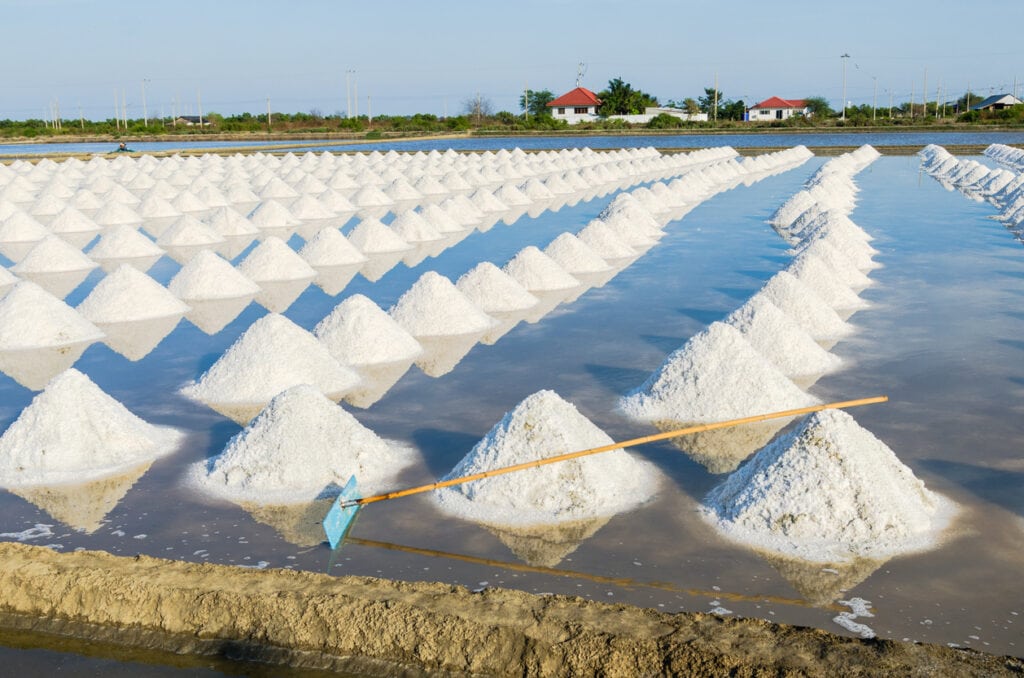What’s the point of this article? To start, I want to tell you the true story of each fake, along with pertinent manufacturing information, value (if any), energetics, and potential side-effects. Read carefully and chew the words slowly, or you might get mental indigestion!
What does “white” mean? In the context of this article, white means fake, and fake means refined. The more a food is refined, the more it has been stripped of its original life force, or nutrients.
Fake #1. Synthetic Fractionated Vitamins
In Latin, vita means life. When vitamins were discovered in the twentieth century, there was an attempt to categorize their life-giving properties. However, the moment that money interests got involved in health, the vita in vitamins was forgotten. The focus was no longer on how they support the life processes of the human body, which require a daily, regular intake of all of the cofactors, enzymes, and minerals found in whole food nutrients to function optimally. If these complete nutrients are missing from the diet, whole food supplements can have therapeutic value and can help fill in the gaps. Store-bought “supplements,” on the other hand, are created in a lab and have only isolated nutrients to offer. These synthetic fractionated vitamins have no therapeutic value. They have a toxic drug effect rather than a nutritional effect.
Synthetic vitamins fakes also contain a byproduct called stereoisomers. In chemistry, molecules naturally spin two ways: they are either levorotating (meaning counterclockwise) or dextrorotating (meaning clockwise). For example, when you see a supplement such as L-Glutamine or L-Tryptophan, you can identify both as having levorotating molecules, which should, and almost always do, naturally turn in that specific direction.
However, synthetic “vitamins” created in a lab—which by definition lack the life-supporting phytochemical and energetic fullness found in the whole vitamin complex—will have more molecules turning the “wrong” direction, meaning they do not spin how nature intends. This is just one of the reasons our cells do not recognize the chemical structure of synthetics. These lab-made fractionated fakes can feed pathogens and/or clog the body’s fluids, triggering the body to protect itself by quarantining them in tissues or organs, causing a host of other problems. If fake vitamin fakes do not act according to nature, we should not expect them to support the natural processes of life.

Another impact of the “labeled” nutrients in packaged foods are nervous system energy disturbances, as many reading this already know. The more refined a food or herb is, the more it begins to fit another category of substance: drugs. These five fakes—staples in many American diets—may be causing drug-like side-effects, both physically and energetically, while also having a negative impact on the environment through manufacturing waste, shipping, low-paying jobs, and profit-chasing.
Fake or white can also mean hydrocarbon-based. For example, the chemical makeup of refined sugar—carbon, hydrogen, and oxygen—share three of the six elements found in crude oil, a hydrocarbon:
Crude Oil Contents
| Element | Percent range |
| Carbon | 83–85% |
| Hydrogen | 10–14% |
| Nitrogen | 0.1–2% |
| Oxygen | 0.05–1.5% |
| Sulfur | 0.05–6.0% |
| Metals | < 0.1% |
Chemistry note: Refined sugar (sucrose) is a disaccharide, meaning it is composed of two monosaccharides. To put it another way, it is a “double sugar” made from two simple sugars. The elemental formula is C12H22O11.
Fake #2. Refined Sugar—The Obvious Culprit
I sat in junior college English, trying to stifle my very rational inner dialogue of What’s the point of living? My teacher, a middle-aged man with gray streaks in his dark hair and a very engaging voice, was explaining how to write an argument paper.
As he paced the floor, looking for his next victim, I noticed his eyes kept finding me. Was he somehow reading my thoughts? After class, I asked if I could speak to him. I told about my suicidal thoughts and morbid fascination with death. In return, he gave me a book called Sugar Blues by William Dufty. I had always felt a connection between what I ate and how I felt, but was food affecting my very thoughts? Intrigued, I wondered if I had a case of the “sugar blues.”
After reading the book, I finally understood why I felt the way I did. I learned that seemingly normal foods such as potatoes, when eaten in excess, could be causing my various bipolar mood, energy, and blood sugar disorders. Within one week of no potato consumption, and much less sugar consumption, my suicidal thoughts were gone.
Manufacture: This begins with juicing and/or a chemically treating sugar cane, beets, or corn. The sugar is then processed, cleaned, and washed. “Impurities” are removed with either lime and heat or calcium carbonate and sulfite. After evaporation and condensation help thicken the juice, it is crystallized in vacuum pans with methylated spirit and glycerin. At this point, unrefined sugar is dried, while refined sugar goes through a centrifuge to separate out the liquid (molasses), then dried in a heated tumbler and ground up.
Value: Pure sugar is a simple combination of carbon, hydrogen, and oxygen—that’s it. Therein lies its value. Thanks to this basic chemical makeup, sugar can get into our cells quickly. It can even save a life in the case of extremely low blood sugar. Together, glucose and fructose form sucrose. Our cells use glucose for energy. If you’re feeling very heavy and stuck, it can lift your spirits and help you experience the sweetness of life. It can ease spasms, relieve pain, and boost energy. Overused, it can do the opposite.
Energetics: Sugar has two effects on energy. Like kindling in a fire, it lights quickly, burns bright, then just as quickly goes out. Heat rises, so a lot of energy goes to the head and upper body. The nerves get excited. Minerals and vitamin cofactors are mobilized to help oxidize the glucose. Your heart beats faster, and you breathe more quickly. It is reactive and acid-forming, thanks to the carbon (think carbonic acid), hydrogen (think hydrochloric acid), and oxygen (think rust-forming) that form its makeup.
After digesting sugar, lethargy and coldness kick in. The nerves and awareness are dulled. Assuming no nutrient-rich foods were eaten with the sugar, fewer mineral and energy cofactors remain. Sugar can cause an acid condition in the blood, giving rise to weak immunity. (The blood should be slightly alkaline.)
Substitutes: Raw, local honey, rice, or other grain syrup; unrefined sugars (such as brand names Sucanat or Rapadura); fruits and sweet vegetables such as carrot, squash, cooked onion, parsnip, and beet; maple syrup; and stevia. There are many more.
Potential side-effects: Since the adrenals send out “fight or flight” signals for any disturbance in the body, they work very hard when blood sugar levels are fluctuating wildly. This can mean lower heat and energy in the system, triggering slow degeneration and potential fungal or yeast infestation. Yeasts love sugar. What our cells cannot use, yeasts will begin digesting, until they grow out of control in the gut and eventually go systemic. In Chinese medicine, we call this “dampness.”
Other potential side-effects of sugar consumption can include ADD, ADHD, foggy head, mood swings, gas, bloating, cramping, diarrhea or constipation, infertility, impotence, heart disease, high blood pressure, obesity, osteoporosis, cancer, arthritis, dental problems, PMS, and blood sugar disorders.
Learn more about how sugar is made here.
Fake #3. Refined Salts: The Real Story, with Good and Bad News
In Chinese medicine, yin and yang are opposite but interconnected forces. If either of these forces shift to the extreme end, you will be out of balance. Salt and sugar have their own yin and yang:
The yin and yang of salt and sugar:
- Refined salt ingestion (too much yin) → sugar cravings.
- Refined sugar ingestion (too much yang) → salt cravings.
The Salty Sea and Cravings: Changing of the Salt Story
After surfing one day, I had an epiphany about salt. There was an itch behind my ear I had to scratch, which is when I noticed a thin film of salt on my finger. I tasted it. Yum! It sure tasted better than the refined salt I was used to. A few years later, I had a girlfriend who loved to lick and kiss my ears. I never really commented because, hey, why question a pleasure so sensual? But one day she admitted it was the taste of the salt she loved! I was a little disappointed because her tender ministrations were more for the salt than for me, but this is when I realized that many of us crave salt. Yet we’re told it’s bad for us. Was this true?
When I was training at The Kushi Institute in 1995, we saw a middle-aged man name Pete who had been battling prostate cancer. Though his cancer had gone into remission after he switched to a macrobiotic diet, at his three-month follow-up he reported all was well except for a lingering ache in his low back that prevented him from bending over and limited his range of motion. This was a problem as Pete did construction work and was very active. The counselor—a stoic Brit with a lovely accent and a dry wit— went through the dietary “prescription” he had written three months earlier, and it didn’t take him long to key in on Pete’s salt consumption.
As it turned out, he was using a low-grade brand of sea salt, and I knew from experience that this brand was slightly “impure.” Pete’s issue was that salt gets diluted into the body’s fluids, which are filtered through the kidneys. His achy low back and lack of mobility were due to his body not being able to process the salt cleanly, causing fluids and blood to stagnate around the kidney area.
A thankful Pete reported back two weeks later to say all his problems had cleared up—and all he did was ditch his decent though impure salt to a cleaner brand with fewer contaminants. In 30 years of clinical practice, I have never seen a case of edema or rise in blood pressure from the use of quality sea salt, in particular, the Celtic Sea Salt brand. I cannot say this about other brands.
Good news: Yes, you can eat unrefined salts! In his book Sea Salt’s Hidden Powers (available as a free download here), Jacques de Langre explains that high-quality sea salts are carefully extracted to preserve the same 84 elements originally in the sea. Himalayan crystal salts are equally rich in trace minerals, and since these minerals occur in a natural matrix, they can be absorbed more easily. (For those who stress about getting enough iron, calcium, magnesium, and other trace minerals, unrefined salts and sea vegetables offer the easiest absorption.)
Bad news: If you consume too much salt, you can become like beef jerky: hard, inflexible, and dry. How much salt each individual needs is a personal calculation, but if your diet consists primarily of whole, unrefined foods—including high-quality, unrefined salt—you are giving your body what it needs to self-regulate. Therefore you can also give yourself the luxury of going by taste rather than some arbitrary measurement.
Manufacture: Salt from the land is mined by drilling and the use of explosives, or it is dug out. Its purity is tested, then it is ground into smaller pieces. Any metal residues are removed with magnets, strainers, or by hand. If there are too many impurities, the salt crystals are dissolved into water and treated like sea brine.
Refined salt from the sea is dried (in the sun or in heaters, evaporators, and flashers at very high temperatures going up to 1,200°F), after which any impurities are removed. The excessive heat makes the sodium crystals split so they become less easily absorbable and irritating to the tissues. Iodine is naturally occurring in unrefined salts, but in refined salts the iodine dissipates due to washing, refining, and drying in high temperatures. For artificial supplementation, synthetic potassium iodide is added back in.
In The New Whole Food Encyclopedia (a wonderful resource on this topic), author Rebecca Wood explains that the FDA approves up to 2 percent “additives” for use in commercial salts. These include anticaking agents and chemicals such as caustic soda or lime, aluminosilicate, yellow prussiate of soda, bleaches, and inorganic iodine—the last of which must be stabilized with dextrose, so that is added as well. Unrefined sea salts are evaporated and dried in a more natural process, which preserves some of the less stable minerals, including iodine.
Value: Our appreciation of salt goes back to the beginning of recorded human history. In Latin, sal means salary, which makes sense as Romans were paid in salt. Obviously, the ancients valued salt as much as we value money today. The Romans, the Celts, tribal peoples, and other communities worldwide valued natural sea-dried salts. Our ancestors dug salt out of the earth and traveled long distances to trade for it. They knew it was critical for life.
Energetics: In small doses, unrefined salts offer a calming, relaxing, and downward energy. A small dose can also catalyze enzymatic reactions, allow proper muscle contraction, and enable smooth flow of nerve impulses. Large doses can be contractive, tension-producing, and cause feelings of heaviness and joylessness (due to the control cycle in the five-element theory of water controlling fire), and also disrupt nutrient absorption. Chronic overuse of salt can damage the kidneys, while a proper amount will nourish them.
Potential side-effects: The list of possible side-effects is extensive and overwhelming. Some of the risks of over-consuming salt are high blood pressure, edema, stomach cancer, osteoporosis, bronchial irregularities, excessive thirst, dehydration, high cholesterol, and strong cravings for sweets. Furthermore, indulging in any sweet cravings will put you at risk of the additional side-effects associated with sugar.
Refined salts are considered “toxic” by many reliable sources—including Jacques De Langre (Sea Salt’s Hidden Powers), Alex Jack (Macrobiotic Path to Total Health), Sally Fallon (Nourishing Traditions), Paul Pitchford (Healing with Whole Foods: Asian Traditions and Modern Nutrition), and Rebecca Wood (The New Whole Foods Encyclopedia)—so the obvious solution is to avoid them in any form. However, since the food supply is so saturated with salt-heavy prepared foods, the next best choice is to minimize how much salt you use by reading food labels (or if you’re dining out, be sure to ask the restaurant staff). The label might clearly state salt or Kosher salt, but it could also be hiding in “seasonings” or “natural flavors.” You may even find actual sea salt on the label and think you’re good. However, there are plenty of refined sea salts out there. You can identify a refined so-called “sea salt” simply by the color, which, of course, is white. Unrefined sea salts, on the other hand, come in a range of colors. They can be beige, pink, gray, red, or even black. It all depends on the mineral content of the location where the salt is harvested.
Learn more about how salt is made here.
Fake #4: White Flour: Fluffy and Soft Outside & Gooey, Sticky, and Gummy Inside
A “Wonder” of a bread.
At nine years old, an energetic yet ignorant boy, I sat eating a PB&J on fluffy, toasted Wonder bread. As I finished the last bite, Mom came in carrying something that looked like a loaf of bread, but not any kind of bread I was familiar with. For starters, it was brown. It also felt dense and hard when I squeezed it, not light and fluffy like my favorite. Then Mom broke the news: “We’re going to try eating this healthier bread for a while.” My brother and I cried, whined, moaned, and complained for days. I presented arguments in favor of going back to Wonder bread: “Look at the label! It’s enriched with vitamins! It must be healthy.” In my defense, I had been raised without eating many vegetables, let alone whole foods. The foreign taste of natural foods would often make me gag. Eventually, Mom gave in.
Refined flours are white, which gives products like Wonder bread eye appeal (especially to kids). But the body digests white flour just like it does white sugar—too quickly. The sugars in refined flours can enter the blood as fast as sugar itself, so metabolically speaking, we need to treat it like we do refined sugar.
Manufacture: The whole kernels of wheat (or any other grain, bean, or seed) are ground in a hammer or blade mill, which chops the grains into particles. This is a high-heat process that damages the fats in the grain. Next, the bran and outer layers are removed (usually through extensive sifting), and the remaining flour is treated with up to 30 chemicals—including four synthetic vitamins to replace the natural nutrients that were removed from the original grain in the first place!
Value: None. May slow down loose bowels via its clogging action.
Energetics: Chewing products made from white flour tells us all we need to know about their energy. In the mouth they become like glue, sticky and gummy. They coat our intestinal lining, inhibiting nutrient absorption and offering plentiful damp and warm food for critters like candida. And as noted above, white flour products metabolize similar to sugar, meaning they can make blood sugar levels can fluctuate wildly. Once the energy is metabolized, the leftover gummy residue can act like a plug in our intestines, slowing everything down.
Potential side-effects: Constipation, blood sugar disorders, candida, general intestinal dysbiosis, irritated intestinal lining (showing up in conditions such as Crohn’s disease, celiac, and irritable bowel syndrome). Also on the list is foggy thinking, and stagnant liver function.
Other potential side-effects: Go back and look at everything on the list of potential sugar side-effects, because they all apply here as well: triggered adrenals, yeast infestations, mood swings, constipation, heart disease, diabetes, and arthritis—to name a few.
Substitutes: The best way to approximate the fluffiness of white flour is to buy or grind your own fresh flour from whole wheat varietals like white or red wheat, or from kamut, quinoa, millet, rice, or whatever your favorite is. (For this, the Lee Household Flour Mill is a worthwhile investment.) The next best option is to mix unbleached white flour with whole grain flours, then ferment them 24 hours in a sourdough type of system.
Learn more about how flour is made here.
Fake #5. Oils: Oxidation Expressway
What are these pimples? I had a defining day in my training as a health professional in 1998. That morning I woke up, groggily made my way to the restroom, and lifted my tired eyes to the mirror. What are all those whiteheads on my chin and jaw? They weren’t there when I went to bed last night! Then I recalled the hydrogenated-oil-filled chips and cookies I ate the day before. I had just finished a paper on trans-fatty acids for my Experimental Nutrition class, and I was frightened by the research and various governmental cover-ups. How did the human body treat this foreign material? If the oils were toxic enough (meaning more highly refined), would the body encapsulate the partially broken down oils and shunt them off somewhere they could not cause damage?
For me, eating refined oils and trans-fats meant that within 24 to 48 hours I would find an array of pimples on my lower face. In the macrobiotic tradition, this is described beautifully as “discharge.” The intestinal and lymph systems are overloaded, and the skin is used as a discharge mechanism.
Greasy stools and gassy guts. When I consumed refined oils, my system did not break them down very well. This meant the dreaded “three wipe” system after number two. It also meant wondering, Why is it so greasy?
I finally realized I had so much gas because refined foods were making my system less and less happy. It wasn’t until eight years after writing my research paper on trans-fats that I finally made the connection between my gassy guts and my own attachments to overeating, especially the five fakes.
Manufacture: When it comes to processing vegetable oil, solvent extraction is standard in the industry. The extracted materials are ground to a coarse meal or shredded to increase the total area of extraction. This “meal” is usually heated to facilitate a better yield, and then fed into a “screw press,” which operates under high pressure. The first yield of oil is set aside and the “oil cake,” or residue, is processed with solvents such as hexane. This assures more product (quantity, not quality, means more $$$). Most of the solvent evaporates, and the rest is boiled off. Next, heavy-duty refining removes those harmful natural colors, odors, and bitterness. The oils are heated and mixed with an alkaline substance to remove “undesirable” fatty acids. After it is degummed with steam, or with water and acid, it is bleached and deodorized over superheated steam (up to 485°F). Finally, we have a processed oil that is sterile, uniform in color, and homogenized—just like assembly-line fast food.
Value: While unrefined oils offer a multitude of fatty acids, antioxidants, enzymes, and potential energy, highly refined oil has no value. It is processed with solvent residues, acids, high heat and pressure, and sodium hydroxide. For certain industrial processes refined oils offer good lubrication value. For human consumption, none.
Energetics: Refined oils are very hard to digest. Oils in general are like fuel. They are part of every cell membrane in the body. They cause heat, but the liver pays the price for digesting and detoxifying the residues of refined oils.
Potential side-effects: Highly refined oils can cause liver stagnation, lymph congestion, hormonal imbalance, intestinal gas, rumbling, cramps, and pain. Since fatty acids line the cell well of every cell in the body, cellular metabolism can be affected. And because refined oils can cause oxidative stress, cholesterol levels may also rise.
Learn more about how olive oil is made here. Check out two other resources on processing and refining edible oils here and here.
Images from iStock/RightOne (main), RightOne (forklift with sugar bags), mekcar (flour grinder), mekcar (salt fields), Chris DoAl (man holding stomach),



